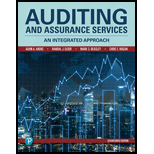
Concept explainers
Describe the following documents and records and explain their use in the sales and collection cycle: bill of lading, credit memo, remittance advice, and
Identify the meaning of bill of lading, credit memo, remittance advice, and accounts receivable trial balance and their use in the sales and collection cycle.
Explanation of Solution
Bill of lading:
It is a document which contains the shipment details of the goods. It acts as a contract between the freight carrier and seller of receipt and shipment of goods. Its use in the sales and collection cycle is that it is important for initiating the shipment of goods and begin the sales cycle.
Credit memo:
It is a document issued by the seller to the buyer in order to reduce the amount owed by the seller from a previously issued sales invoice. Its use in the sales and collection cycle is that it helps to process and record the sales returns so that the seller can arrive at the exact amount to be collected from the buyer.
Remittance advice:
It is a document sent by the customer to the seller. It informs the seller that the invoice has been paid. Its use in the sales and collection cycle is that it helps to process and record the cash receipts. It also helps the seller to match the invoices and payments and be sure that the right amount has been collected from the customer.
Accounts receivable trial balance:
It is a list that contains the amount receivable from all the customers at a point of time. It includes the total outstanding balance and the number of days it has been outstanding. Its use in the sales and collection cycle is that it helps to know the exact amount to be collected from different customers and also helps to figure out the possible bad debts.
Want to see more full solutions like this?
Chapter 14 Solutions
Auditing And Assurance Services
- General accountingarrow_forwardQuestion: The balanced scorecard approach includes a) Only financial measures b) Only non-financial measures c) Both financial and non-financial measures d) Only customer measuresarrow_forwardCould you explain the steps for solving this General accounting question accurately?arrow_forward
- Can you solve this general accounting problem using accurate calculation methods?arrow_forwardCan you solve this general accounting problem using appropriate accounting principles?arrow_forwardPlease provide the correct answer to this general accounting problem using accurate calculations.arrow_forward
- Can you help me solve this general accounting question using the correct accounting procedures?arrow_forwardPlease explain the solution to this general accounting problem with accurate principles.arrow_forwardI need the correct answer to this general accounting problem using the standard accounting approach.arrow_forward
 College Accounting (Book Only): A Career ApproachAccountingISBN:9781337280570Author:Scott, Cathy J.Publisher:South-Western College Pub
College Accounting (Book Only): A Career ApproachAccountingISBN:9781337280570Author:Scott, Cathy J.Publisher:South-Western College Pub College Accounting, Chapters 1-27AccountingISBN:9781337794756Author:HEINTZ, James A.Publisher:Cengage Learning,Principles of Accounting Volume 1AccountingISBN:9781947172685Author:OpenStaxPublisher:OpenStax College
College Accounting, Chapters 1-27AccountingISBN:9781337794756Author:HEINTZ, James A.Publisher:Cengage Learning,Principles of Accounting Volume 1AccountingISBN:9781947172685Author:OpenStaxPublisher:OpenStax College Accounting Information SystemsAccountingISBN:9781337619202Author:Hall, James A.Publisher:Cengage Learning,
Accounting Information SystemsAccountingISBN:9781337619202Author:Hall, James A.Publisher:Cengage Learning, Financial AccountingAccountingISBN:9781305088436Author:Carl Warren, Jim Reeve, Jonathan DuchacPublisher:Cengage Learning
Financial AccountingAccountingISBN:9781305088436Author:Carl Warren, Jim Reeve, Jonathan DuchacPublisher:Cengage Learning Financial AccountingAccountingISBN:9781337272124Author:Carl Warren, James M. Reeve, Jonathan DuchacPublisher:Cengage Learning
Financial AccountingAccountingISBN:9781337272124Author:Carl Warren, James M. Reeve, Jonathan DuchacPublisher:Cengage Learning





